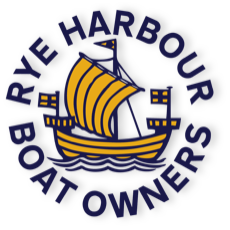Adventures on the Thames
Ok, so I know this is not local to us at Rye and indeed it could & should be argued that a 15ft inflatable SUP board is not a boat either but as owners of a boat and indeed active members of the association we thought it might be nice to share our little adventure with you.
If there is one thing we love more than being on the water it is an adventure and so in one of our mad moments we decided it might be ‘fun’ to paddle board the non-tidal stretch of the Thames.
The navigable stretch of river runs from Lechlade to Teddington Locks. This is about 130 miles and 43 Locks. So on our 15ft inflatable board heavily loaded up with tent/sleeping bags and cool-box filled with supplies (not even cold beers) we set off.
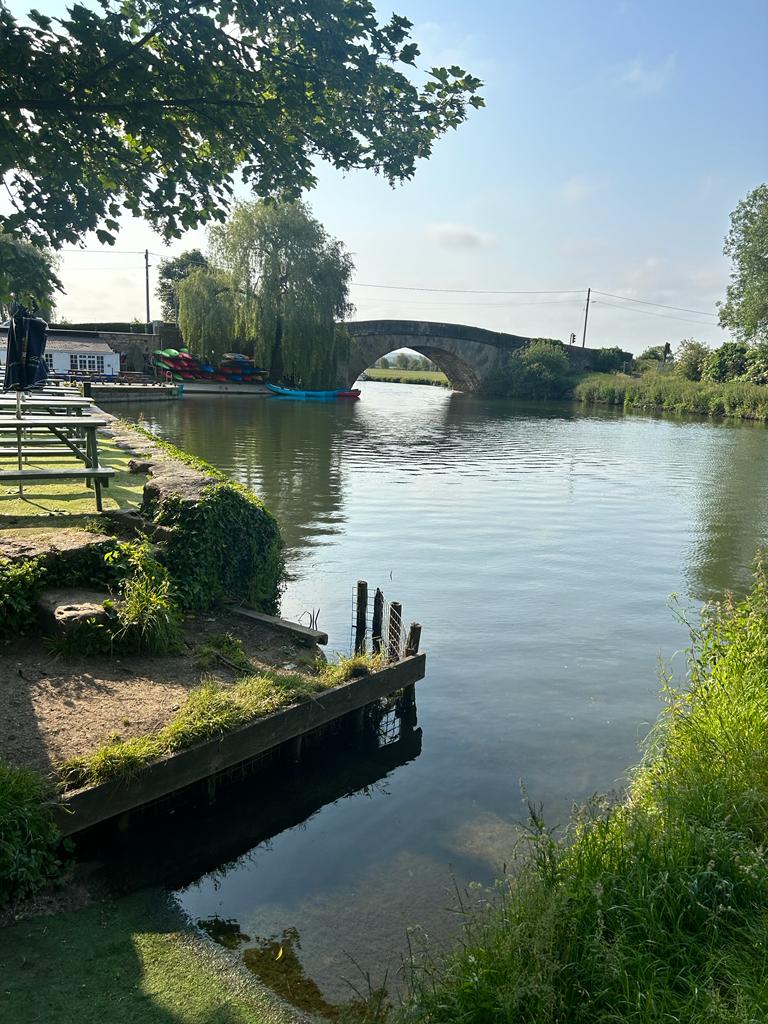
Day One
We managed to get a lift to Lechlade and blew the board up, loaded up and set off. Lovely weather to start with; although we were aware that we might have a little head wind in the afternoon but did not see the point of putting the adventure off and wanted to get away from ‘civilisation’ as quickly as possible.
A lovely day albeit with the forecast headwind ‘strength building’ says my husband! Blasted hard work says me!
The locks were a respite on the arms and shoulders from the paddling but each one a challenge in finding where abouts to haul out and portage all our gear to for loading back up. Some locks were more user friendly than others as indeed were the lock keepers! Most of the locks were ‘self-service’ which clearly didn’t bother us as we were not using them but frustratingly at times there was a lack of water and toilets. After 9 hours of paddling and locks we found a spot to haul out and set up camp (wild camping). The night was OK and apart from the odd dog walker at first light we were pretty much alone.
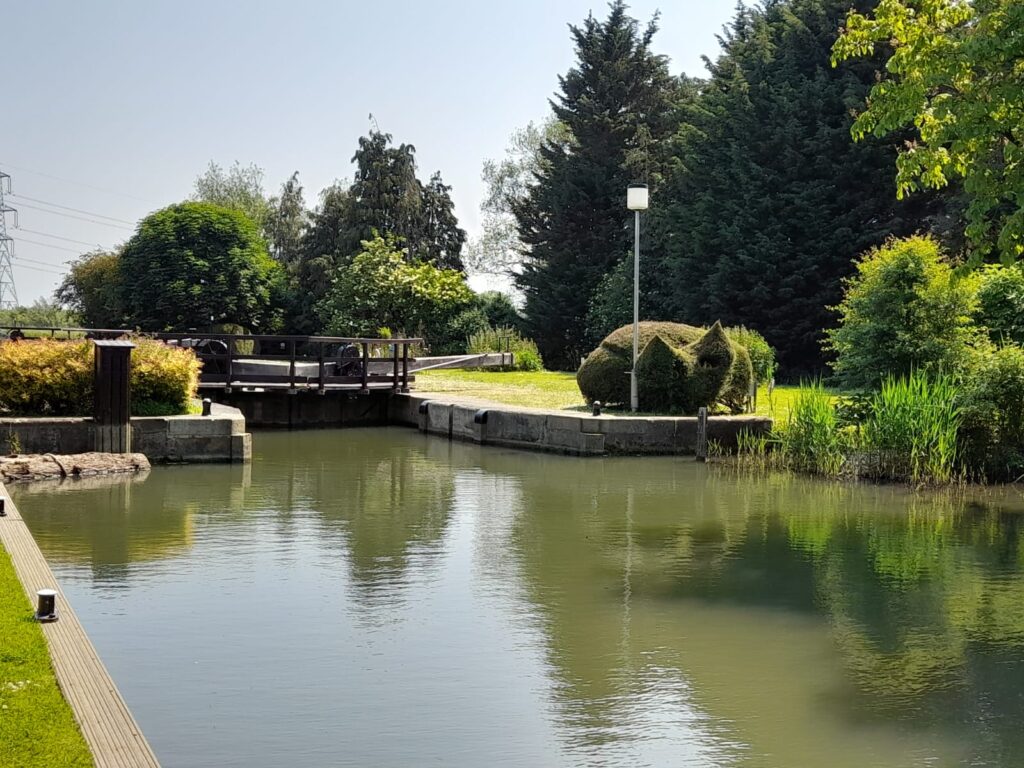
Day Two
A quick look at the weather said there was a 20% chance of a thunderstorm today but lovely weather the rest of the week. So off we went knocking off more miles and more locks. Oxford was ‘interesting’ as there was a huge regatta and we found ourselves surrounded by teams of racing rowers and people calling out to us to say ‘paddlers go to the left’ ‘paddlers go right’ – easier said then done with choppy waters and boats in every direction! I was pleased to get out of Oxford where we took refuge under a tree from a heavy downpour in Abingdon. On a positive note we were feeling OK with no serious aches and pains and just the sound of thunder in the distance. We called it a day after another 11 hours and set up camp among some trees between the towpath and the river. Was an OK spot apart from the obvious passersby on the towpath.
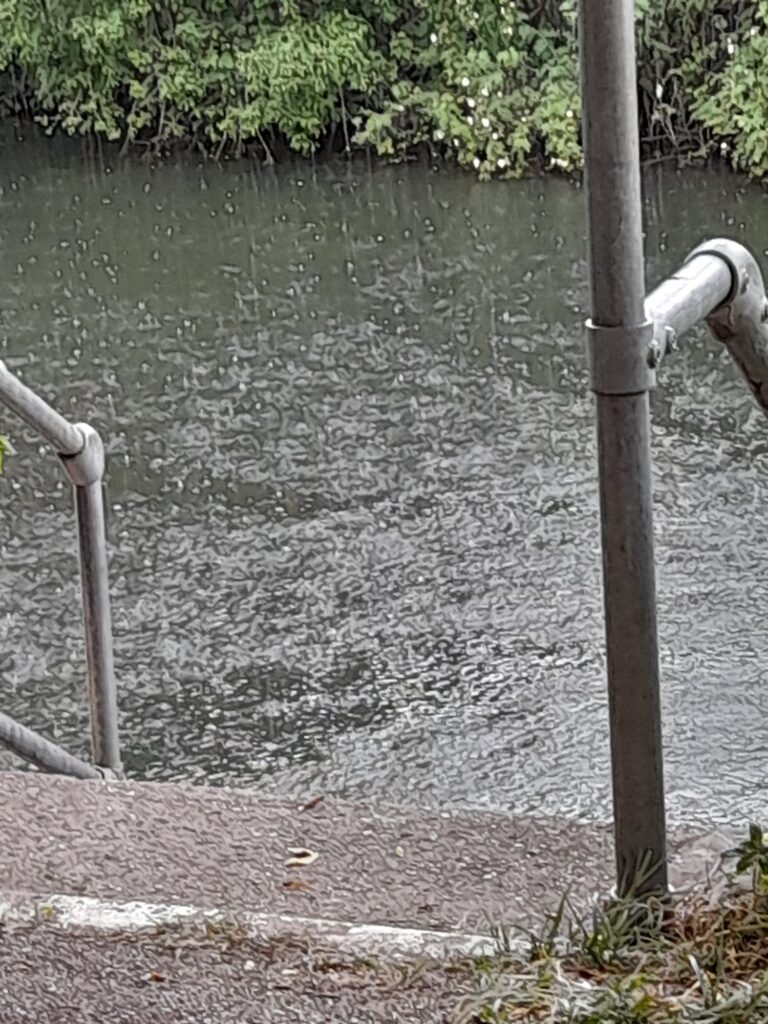
Day Three
Another quick look at the weather, which had been updated and AGAIN they gave the risk of isolated thunderstorms. We set off early hoping to make some headway before thunderstorms might decide to come and play. Another day, another regatta – this time it was the Reading regatta and so we just tried to hug the bank and keep out of the way. A few near misses with rowers not seeing us but was having quite a good day until the brewing thunderstorm decided to burst directly overhead! We managed to get out at a lock and off load our gear and place the paddle board over us for shelter. We were sheltering for 80 mins during which time the river rose about an inch and was slapping over the dock we were on. As soon as it had calmed down we made for the water to try to catch up on lost time and ended up finding a really lovely spot to camp. Someone had gone to the effort of building/clearing a ‘swim’ and putting mulch down on the ground. Perfect and much needed – only us and about a thousand mosquitos…..
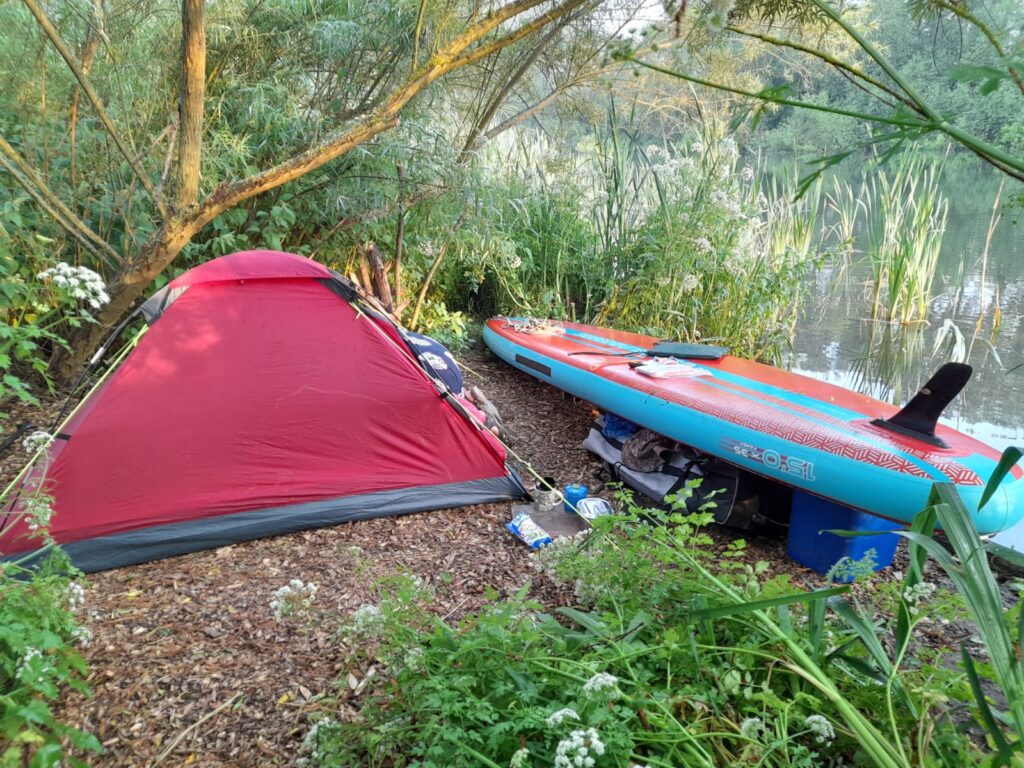
Day Four
We checked the weather and guess what ? You got it – more thunderstorms forecast – woohoo! We set off again and had made excellent progress despite rain and headwind. We made Windsor and had a lovely paddle round past the castle, racecourse and old town. All very picturesque. As we left Windsor we could see the storm brewing but this time really had nowhere sensible to hide (trees were not my first option in a thunderstorm). Eventually we stopped at a little island in the middle of the thames and just sat on the bank covered up and waiting for it to pass. We set off again and with a little help from the flow made good progress. Lady Luck was on our side today as we were seeking somewhere to camp for our last night and had an offer from 2 local paddlers to set up camp on their land where their boat was moored! WOW – they were super kind, fed and watered us and had our first beer.
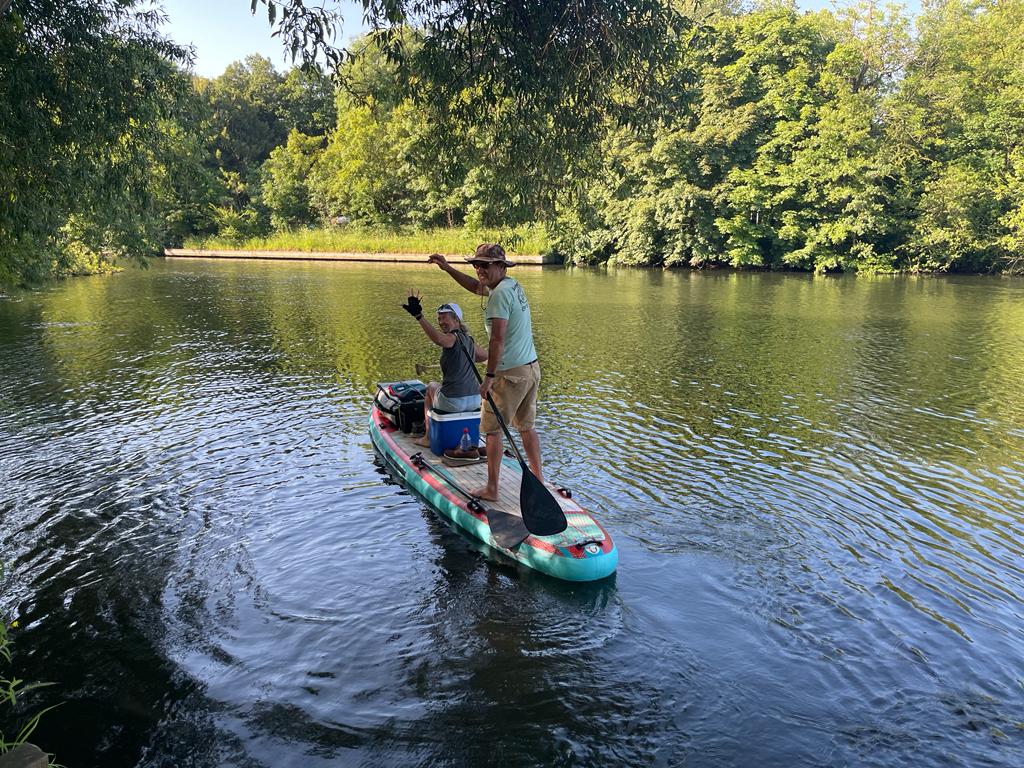
Final Day
Set off later than normal after saying our thank yous and farewells with a little under 20 miles to go till we reached our final destination. We were romping along for half of this and feeling good until the wind decided to give us 20mph in our faces and slow us down to a crawl…… We still made Teddington by 3.23pm and a nearby pub very shortly afterwards where we sat and filled our faces whilst waiting for our lift home.
A little sunburnt, a lot of blisters, a little achy and a little tired BUT a lot of laughter, escapism, satisfaction, achievement and now ready for our next challenge and adventure.
Mitch seeks drama
This time the misadventure wasn’t mine, and we were the rescuers. It was 1991, and my boat was a slightly larger Sabre 27 named Wings of Dawn, with extra luxuries including a 2-way radio and a Decca Navigator (predecessor of GPS).
I had invited my friend Mitch for his first (and only ever) sail with me. As a cool Liverpudlian rocker, he came just in order to see what possible attraction sailing could hold for me.
The weekend was quiet, little wind and a bit misty, but we reached Brightlingsea without incident, and spent an agreeable evening ashore.
Next morning was still misty, but I decided to head across the estuary to the Buxey, an offshore sandbank where I had previously swum with a family of seals. They were not at home for us, and Mitch began to complain that sailing lacked drama.
Half an hour later our ship’s radio came to life with a report that black smoke had been seen rising from a white yacht. The position given was only some 2 miles from us across the Buxey Sands, so with a calm sea and rising tide I reckoned we could probably get across to render assistance.
Due to the mist we could not see any smoke, but we entered the position on the Decca and set off at full speed. Mitch watched the echo-sounder and I prepared fire extinguishers. After about a mile we could see a huge pall of smoke ahead, through which we made out a white hull and the top of its mast.
Getting nearer we saw the mast fall, while the boat was ablaze from stem to stern. It seemed impossible anyone aboard could have survived.
Soon we spotted a small semi-inflated dinghy a few hundred yards upwind of the fire, with one man on board. Having picked him up shaken but uninjured, we were very relieved to hear that he had been alone. Meanwhile, flares on the boat were firing off, and gas canisters exploding.
We stayed around at a safe distance until a police launch arrived, took our passenger and his inflatable, and went over to direct their hose on the fire.
A proper fire-fighting boat then came to join in, and we turned away to resume our quiet sail up the Blackwater. The log records “Mitch satisfied”.
A muddy solo weekend
It was August Bank Holiday 1998, and my promised crew had cried off. With a good forecast I decided to go solo, sailing from Maldon around to Burnham on Crouch.
After an early drive from London I was away down the Blackwater by 7am, and out of the estuary a couple of hours later. The wide waters of the Thames Estuary led us round via the shallow Ray Sand Channel into the Crouch.
Due to the volume of yacht racing I turned off into the quieter river Roach, seeking an anchorage for the night in one of its tributaries. Marshes and reeds on either side, then a wide creek on the port side, formed into a cul-de-sac by a low dam. With no through traffic, this should be ideal, I thought, motoring cautiously into it.
After maybe 100 yards we slowed and stopped. I realised we had grounded in soft mud, but motor ‘full astern’ had no effect, nor even jumping overboard to push. All around me were the marshes of Foulness Island, a prohibited Military Exercise Area. I was not unduly concerned, as a quiet night would be assured, followed by floating off at breakfast time.
Only then I checked my tide table, to find that I had grounded precisely at high water, and that the next tide higher than this was not due for almost a week!
Time to take stock; if I could not escape on the morning tide I would use the inflatable to paddle to the nearest boatyard, a mile upstream, ask them to keep an eye on the boat, and get a taxi round to Maldon.
This not being my favourite solution, I worked to gain the best chance of re-floating. I filled a bucket with river water to clean myself and boat later, spent 2 hours in the thick mud with a paddle digging a trench behind the boat, and setting the anchor in deeper water beyond. To increase buoyancy I lashed the fenders under the hull and filled the inflatable with all the heaviest movable items. Nothing more I could think of, so to bed.
I was up at first light, but we were still not up level, and by 0545 the tide had turned. The motor astern at full revs had not shifted us, and after my last despairing effort pulling on the anchor chain my back had protested loudly and I lay in pain on the cockpit floor.
My luck then changed, not before time, as a large fishing boat came by. I struggled to my feet, waved, and it came across, passed us a line, and gradually managed to tow us clear. It only remained for me to restore order on board, consider the lessons learned, and sail back (very gently) to Maldon.
Up the schedule without a motor
May 2015, and we were 5 days into our summer cruise to Holland in my current boat, Schamune. I had sailed solo round to Dover, where my stalwart crew and neighbour Michael had joined me, and we listened to a forecast of “gales in Thames, Dover, Wight SW force 6-8, occasionally 9. Outlook; gales in all areas”. Far from ideal!
So we decided to postpone our channel crossing, and instead hugged the coast up to Ramsgate. With minimal sail up we enjoyed a speedy and smooth passage, and arrived to find around 50 of the “Little Ships” in harbour preparing for their pilgrimage to Dunkerque.
In the morning the wind had dropped to a sailing breeze, and we made our crossing to Dunkerque East without mishap.
The next day we followed the Belgian coast past Nieuwpoort and Ostend, and reached Zeebrugge, where the small marina was a haven of peace with blackbirds singing, and a good restaurant.
Next morning a fresh Westerly breeze and East-going tide promised us an easy passage up the Schelde estuary to Flushing/Vlissingen.
Shortly after leaving the harbour, Trouble manifested itself as a loud noise from the motor, as if the gears were grinding. So while Michael helmed I crawled into the engine compartment to top up the gear oil, but this made no difference.
We were by now making good progress under full sail towards Flushing. Checking the almanac it looked safer to continue, aiming for the old harbour rather than the busy main one. We would need to cross to the North side of the busy shipping lanes as soon as a gap in traffic allowed, locate the small harbour, make a neat turn into the narrow entry between harbour walls, and come to a halt before colliding with the lock gates.
We called the harbourmaster, who would watch out for us and arrange for an engineer to stand by.
With trepidation, we sailed through a gap in the line of shipping, located the harbour, Michael dropped the sails and I started the motor to bring us in neatly (if noisily). The lock had already been opened for us, and a pontoon berth prepared.
The feelings of relief and relaxation (plus a smug satisfaction) were immense.
Engineer Arjan Zilver arrived, diagnosed the problem- a broken alternator- and obtained a replacement.
A memorable cruise in the Dutch waterways then followed with several crew changes; Michiel de Bruin, then Nigel and Steve, and finally Peter and Liz for the return overnight passage.
Motor-boating adventure
As a diversion from sailing, this may explain Wendy’s more general aversion to my boating.
While we lived on Eel Pie Island we had at the end of our garden a private pontoon on the Thames. We bought a small 16ft motor cruiser which we re-christened Bumble. Over the following 3 years Bumble took us as far upriver as Guildford and Goring, and downriver past Tower Bridge.
This small adventure was nearer home. We had gone a short way upriver to a party in a Teddington boathouse. Afterwards we gave a lift to Richmond for a couple who lived locally, and we all enjoyed the short cruise downriver by starlight.
Having set them down in Richmond Wendy and I set off homeward, but half-way to the Island the outboard cut out, leaving us drifting mid-river. We were not left totally helpless however, as our little galley was equipped with a saucepan and a bucket, which we were able to use as paddles, one at each side.
With vigorous paddling we made our way very slowly to the end of the Island, which is a tangle of trees, mud and undergrowth, the home of foxes and other wild creatures. Here we thankfully grabbed the first trailing branch we could reach and pulled Bumble in to the bank. Having made her fast to a tree we scrambled ashore in pitch darkness, feeling our way through mud, cobwebs, banks of brambles and nettles until we reached civilisation and home.
We didn’t mean to go to – Hastings
Some mishaps can be foreseen, but others form the “unknown unknowns”.
In 1964, my third sailing season, I decided to venture further, and try the South Coast with ex UCL friends John and Graham.
The log records several small adventures on the outward leg, featuring variously a weather balloon, a Bexhill mermaid, fire-ships, and more than one embarrassment when our outboard stopped at the wrong moment. The highlight of the outward trip was rounding Beachy Head lighthouse at nightfall, followed by a wonderful few hours sailing by moonlight in a moderate following breeze past the white cliffs of the Seven Sisters and into Newhaven.
We turned back at Shoreham a few days later, spent another night in Newhaven, and then our next target was Rye. The day started well, and we rounded Beachy Head again, a westerly tailwind increasing and the sea building as we passed Bexhill and Hastings at an increasing pace, all set to reach Rye as planned around high water.
The “unknown unknown” suddenly occurred when without any warning the rudder snapped off.
The boat turned broadside-on, we dropped the wildly flapping sails, and fished the remains of the rudder from the sea, then jury-rigged an oar to steer with, and raised the storm jib to drive us. This was of course much slower and a bit more erratic than before, and the wind and sea seemed wilder. We would not be able to reach Rye that night.
Half an hour later we were glad to see a fishing boat approaching, the Valiant of Hastings, and grateful to accept the offer to tow us back into its home port. Another hour and we dropped anchor in the lee of the harbour wall, and thanked skipper Brian Stent, who was also captain of the lifeboat. The only reward he would accept was a donation to the RNLI
Graham took the remains of the rudder ashore, and remarkably he returned less than 2 hours later with a replacement, hand-made of straight-grained hardwood, twice as strong as the old plywood one.
We tied up for the night to the broken harbour wall, before continuing our homeward cruise.
Half a century later when Wendy and I moved to Hastings I found that the Valiant was still there, and had become an exhibit in the open air museum.
Finding Holland
The Blackwater Sailing Club planned a rendez-vous for cruising members in Zeeland, southern Holland, in summer 1989. This seemed a good opportunity to extend our cruising range with 100 miles of open sea, so with my son Julian and brother-in-law John we prepared Wings of Dawn, including liferaft hire and a state-of-the-art Radio Direction Finding set (RDF was a precursor of Decca and now GPS)
I planned an overnight crossing, to give us daylight for the start from the Thames Estuary and for our arrival up the Schelde to Flushing.
We set off from the Blackwater on a fine morning against a steady NE wind, with a forecast of clear weather, but with a further outlook of patchy sea mist. (thankfully not ‘fog’) With the RDF we picked up directional signals from Southend and Amsterdam. The set had a compass on top, and headphones, so by turning the set around we could read off the bearing of each signal, and by drawing a line on our chart from each station we were able to plot our position.
We cleared the Thames Estuary in daylight, using the buoys and our echo-sounder to avoid sandbanks, with just one scare when the sounder read only 5 feet while in the Black Deep. (Turned out to be 65 feet, more than the sounder could manage)
At sunset we reduced sail, checked our position with North Foreland and Ostend, and had crossed the southbound commercial shipping lane before midnight. It was a clear starry night, and we kept watch on the lights of passing shipping in the northbound lane.
One set of lights disappeared, reappeared, disappeared again- the sea mist. When it reappeared it was much nearer, and closing with us fast. We tacked round and tried to start the engine. Julian, who had been off watch below, leaped out of his bunk to see both red and green lights, and a white light above them, rising ever higher as the ship approached. He succeeded in starting the engine, so we managed to get clear just before it surged past us, leaving us rocking in its wash, with only a smell of diesel lingering in the night air.
Our position by RDF was becoming very approximate, hindered by the dark night, the way the little compass bounced around due to the waves, and the faint sound signals against the sounds of the sea.
By 0400 I reckoned we were too far north, so changed to a more south-easterly course towards Flushing. By 0800 we started to see various unidentified buoys and towers, and later a shipping lane south of us.
Shortly after 0900 we sighted land, a breakwater shrouded in dark mist, with several towers and wind generators. With a quick look at the pilot book John declared it was Zeebrugge- wrong port, even the wrong country!
At least now we knew exactly where we were, so we had no further trouble motor-sailing up the Schelde estuary past Breskens, and reaching Flushing by 1330, where we locked (downwards) into the canal, and went ashore for customs, immigration and a well-earned cold beer.
